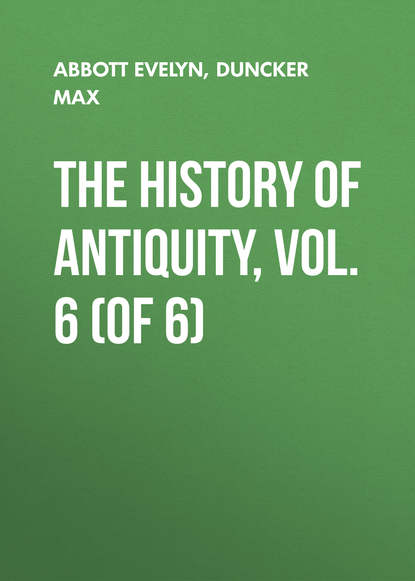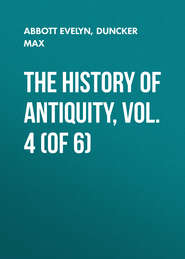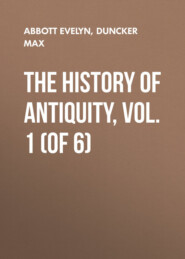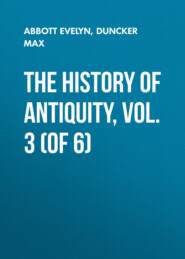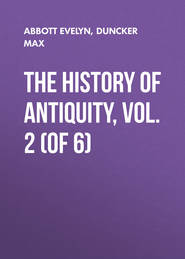По всем вопросам обращайтесь на: info@litportal.ru
(©) 2003-2024.
✖
The History of Antiquity, Vol. 6 (of 6)
Настройки чтения
Размер шрифта
Высота строк
Поля
Justin. 1, 8.
179
The reading "year 4" in the first is confirmed by "year 5" in the second inscription. Lepsius ("Monatsberichte Berl. Akad." 1854, s. 224, 495) has examined the difficulties which arise regarding the time of Cambyses' campaign against Egypt, from the contradiction between these dates and the statements of the Greeks.
180
The inscriptions also give the name Cambyses in the form Kambuza.
181
Lepsius, "Z. Aegypt. Spr." 1874, s. 76.
182
De Rougé, "Revue Archéol." 8, 37 ff.; Brugsch, "Hist. d'Egypt," p. 267, 269. In the "History of Egypt," Brugsch reads Uzahorenpiris for Uzahorsun.
183
Stephen. Byz. Ἀγβάτανα Βάτανα Ἄμαθα. Cf. V. 307, and von Gutschmid, "N. Beitrage," s. 96.
184
Herod. 3, 3, 33.
185
"Excerpt. de virt." p. 557 = 10, 13.
186
Plato, "Legg." p. 691, 694, 695.
187
Herod. 3, 73.
188
Justin. 1, 9.
189
So Oppert according to the Persian inscription in "Journal Asiatique," 4, 17, 385, 386; and according to the second series, "Records of the Past," 7, 90.
190
Barziya in the Babylonian text. Smerdis, the favourite of Polycrates (Anacreon, fragm. 4, ed. Bergk), was no doubt named after the brother of Cambyses.
191
Sachau, "Albiruni," p. 205; Nöldeke, "Tabari," s. 91, 271.
192
Elul and Tisri fall in September and October. The last year of Cambyses is 522 B.C. According to Herodotus, Cambyses reigned seven years and five months, and the Magian more than seven months; the two make up eight years. The number of the Persian days of the month are repeated in the Babylonian version of the Behistun inscription. Hence the Persians adopted the year of the Assyrians and Babylonians as well as their cuneiform writing, but they had independent names for the months. Unfortunately the names of the months in the Babylonian text are more frequently destroyed than not, so that we can only be certain in giving Kislev (November-December) as corresponding to the Athriadiya of the Persians, Tebet (December-January) to Anamaka, Iyar (May-June) to Taigarshis. Oppert maintains that we can also identify the Babylonian Adar or Veadar (Febr. – March) with the Viyakhna of the Persians; but the text is uncertain in this passage. Finally, we may with tolerable certainty regard Garmapada (i. e. the path of heat) as corresponding to July and August, to the Tammuz or Ab of the Babylonians. If Viyakhna is really Adar, the proclamation of the Magian took place in March, 522 B.C., and his coronation in Garmapada (July and August). This according to Darius was followed by the death of Cambyses. The two tablets quoted date from September and October in the first year of Barziya. According to Herodotus, the Magian reigned more than seven months after the death of Cambyses, i. e. down to the spring of 521 B.C. According to the inscription of Behistun, Darius slew him on the tenth of Bagayadis (i. e. sacrifice to the gods), which would thus be parallel to the Nisan of the Babylonians, i. e. to our April.
193
Herod. 4, 166.
194
"Antiqu." 11, 2.
195
Herod. 3, 89.
196
Herod. 5, 25.
197
Herod. 3, 88; 7, 78.
198
Ctes. "Pers." 13. The names of the Seven in Ctesias have been discussed already, Vol. V. 329 n.
199
Herod. 3, 83, 84, and below, p. 221, 222.
200
Herod. 4, 83; 5, 25, 30.
201
Vol. V. 326 n.
202
Herod. 3, 72, 77.
203





